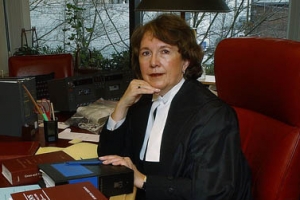
Asked why she decided to study law, Madam Justice Lynn Smith answers, “Who knows?” Uncertainty of motive, however, does not seem to have inhibited either her abilities or her commitment. Her decision to study law seems to have stemmed from her interest in social change and because, in her words: “it seemed like a good fit, especially with a philosophical undergraduate background.”
It was while abroad with the Company of Young Canadians that Smith decided to apply to law school. While the LSAT was not required for admission in those days, she nonetheless decided to take the opportunity to write the exam in Florence. While Smith observes that there is now “a fairly good correlation between performance in law school and your LSAT score,” at the time she wrote the exam “there was a lot of general knowledge on it that had little application to Canadians.” Later, as a member of the Board of LSAC and of the Test Question Review Committee, she oversaw important changes to the exam.
Arriving at Allard School of Law in the fall of 1970, Smith describes herself as “totally intimidated.” Nonetheless, she excelled at law school finishing at the top of her class in all three years of study. On top of her studies, Smith worked part time as a museum guard and had her work published in the UBC Law Review.
Smith recalls that there were few women in her class of 225 students. “The profession was very conservative at the time.” She recalls being especially close to Margaret Jackson, Penny Baines and Judy Clark. She was committed to women’s initiatives: she participated in the occupation of the faculty washroom, wrote articles about discrimination that women faced in finding articles, and even represented a friend at the BC Human Rights Tribunal to challenge discriminatory hiring practices.
Smith recalls that there were no women professors and she does not recall reading a single judgment by a female judge. As a woman in the legal profession, Smith says that “you had to have tough skin.” Smith says that her professors were excellent teachers, noting in particular Bertie McClean, Leon Getz, Chris Carr and Jim Matkin.
After law school, and midway through her articles, Smith became the sole clerk for the entire British Columbia Court of Appeal. The experience, according to her, gave her “a deep appreciation for the difficulties of being a judge.” While in practice, she worked as an adjunct faculty member teaching Women and the Law and Evidence.
In 1981, Smith phoned Dean Lysyk to join the faculty full-time, leaving her position as a partner at Shrum Little. She taught a variety of subjects, including Property, Evidence, Civil Litigation and Creditors’ Remedies, although her primary research interest was - and still remains - the Charter. In addition to her teaching and research, she served as Chair of the Women’s Legal Education and Action Fund, and she served as Dean of Allard School of Law from 1991 to 1997.
Smith says that it was her desire for “novelty” which led her to apply for a position on the Supreme Court of British Columbia. She retired from the court in 2012 and is now focusing her attention on teaching and writing.
Lynn Smith was the recipient of the Lifetime Achievement Award at the 2016 Allard Alumni Association Achievement Awards ceremony held on April 27th, 2016. For more, listen to the Allard Law History Project Interview with Lynn Smith, and watch her 2016 Allard Alumni Achievement Award Video:
First published on January 21, 2021.